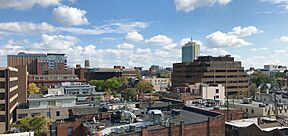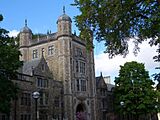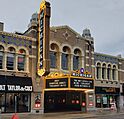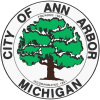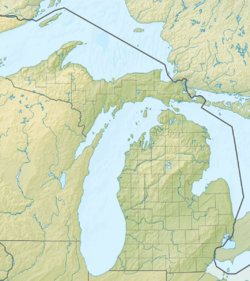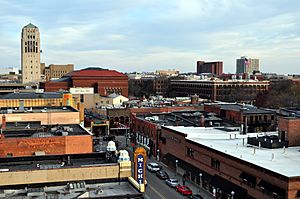Ann Arbor, Michigan facts for kids
Quick facts for kids
Ann Arbor
|
||
|---|---|---|
|
||
| Nicknames:
A2, A2, Tree Town, People's Republic of Ann Arbor
|
||
| Country | United States | |
| State | Michigan | |
| County | Washtenaw | |
| Founded | 1824 | |
| Incorporated | 1833 (village) 1851 (city) |
|
| Founded by | John Allen and Elisha Rumsey | |
| Named for | The wives of the city's founders (both named Ann) and the bur oak in the area | |
| Government | ||
| • Type | Council–manager | |
| Area | ||
| • City | 29.09 sq mi (75.35 km2) | |
| • Land | 28.22 sq mi (73.10 km2) | |
| • Water | 0.87 sq mi (2.25 km2) | |
| • Urban | 159.57 sq mi (413.46 km2) | |
| • Metro | 722 sq mi (1,870 km2) | |
| Elevation | 840 ft (256 m) | |
| Population
(2020)
|
||
| • City | 123,851 | |
| • Estimate
(2023)
|
119,381 | |
| • Rank | 231st in the United States 5th in Michigan |
|
| • Density | 4,388.14/sq mi (1,694.28/km2) | |
| • Urban | 317,689 (US: 129th) | |
| • Urban density | 2,214.6/sq mi (855.0/km2) | |
| • Metro | 372,258 (US: 148th) | |
| Demonym(s) | Ann Arborite | |
| GDP | ||
| • Metro | .556 billion (2022) | |
| Time zone | UTC−5 (Eastern (EST)) | |
| • Summer (DST) | UTC−4 (EDT) | |
| ZIP code(s) |
48103–48109, 48113
|
|
| Area code | 734 | |
| FIPS code | 26-03000 | |
| GNIS feature ID | 0620133 | |
Ann Arbor is a city in Michigan, United States. It is the main city of Washtenaw County. In 2020, about 123,851 people lived there. This makes it the fifth-largest city in Michigan.
Ann Arbor is located on the Huron River. It is known for being a college town. The famous University of Michigan is here. The university greatly influences the city's economy. It employs many people, especially in its medical center. Ann Arbor is also a hub for high-tech companies. These companies are often drawn to the city because of the university's research.
Contents
History of Ann Arbor
Ann Arbor was founded in 1824 by two land buyers, John Allen and Elisha Rumsey. They named the town after their wives, both named Ann. They also named it for the many bur oak trees in the area. The local Ojibwe people called the settlement kaw-goosh-kaw-nick. This name came from the sound of Allen's sawmill.
Ann Arbor became the main town of Washtenaw County in 1827. It became a village in 1833. A group of land buyers offered land to the state of Michigan for its capital city. Ann Arbor lost this bid to Lansing. But in 1837, the land was chosen for the University of Michigan. The university moved here from Detroit.
Since the university came in 1837, Ann Arbor and the university have been closely linked. The city became a travel center in 1839 when the Michigan Central Railroad arrived. More settlers came in the 1840s and 1850s. These new settlers included Germans, Irish, and African-Americans. In 1851, Ann Arbor officially became a city.
During the 1960s and 1970s, Ann Arbor became known for its progressive ideas. It was a center for student movements and protests against the Vietnam War. Students for a Democratic Society, a big campus group, held its first meetings here in 1960. In 1965, the first "teach-in" against the Vietnam War happened in Ann Arbor. These movements led to changes in city rules. For example, new rules against discrimination were put in place.
In 2003, voters approved a plan to protect green spaces. The city bought land rights to keep farms and natural areas from being built on. In 2010, Forbes magazine called Ann Arbor one of the most livable cities in the United States.
Geography and Landscape
Ann Arbor is located along the Huron River. The river flows southeast through the city towards Lake Erie. Ann Arbor is the main city of its metropolitan area. This area includes all of Washtenaw County.
The city has hills and valleys. The land gets steeper near the Huron River. Ann Arbor is nicknamed "Tree Town." This is because of its name and the many trees in its parks and neighborhoods. The city has over 50,000 trees along its streets. It also has 157 city parks. Some large parks and a university park are along the Huron River.
The Nichols Arboretum is a 123-acre park owned by the University of Michigan. It has hundreds of plant and tree types. The university's Matthaei Botanical Gardens are also nearby. They have 300 acres of gardens and a large tropical plant house.
Cityscape and Downtown
The University of Michigan greatly shapes Ann Arbor's look. The university owns a large part of downtown. Downtown Ann Arbor has some of the city's oldest buildings.
Important places downtown include the Michigan Theater and Tower Plaza. Tower Plaza is Ann Arbor's tallest building. Downtown is also home to several Fairy Doors. These are tiny, artistic doors hidden around the city.
Downtown Ann Arbor hosts many big events. The Ann Arbor Art Fairs are a popular example. These fairs bring in hundreds of thousands of visitors each July. During these events, many downtown streets become pedestrian malls (streets just for walking).
Other Areas
Ann Arbor's neighborhoods have different styles of homes. You can find classic 19th-century houses and modern homes. The Old West Side neighborhood has kept its 19th-century look. It is listed on the National Register of Historic Places.
Climate
Ann Arbor has a humid continental climate. This means it has four clear seasons. Winters are cold and snowy. Summers are warm to hot and humid. Spring and autumn are in-between seasons. The area gets more clouds in late fall and early winter due to the Great Lakes.
| Climate data for Ann Arbor, Michigan (UMich, 1991–2020 normals, extremes 1881–present) | |||||||||||||
|---|---|---|---|---|---|---|---|---|---|---|---|---|---|
| Month | Jan | Feb | Mar | Apr | May | Jun | Jul | Aug | Sep | Oct | Nov | Dec | Year |
| Record high °F (°C) | 72 (22) |
68 (20) |
85 (29) |
88 (31) |
95 (35) |
103 (39) |
105 (41) |
104 (40) |
99 (37) |
91 (33) |
78 (26) |
67 (19) |
105 (41) |
| Mean maximum °F (°C) | 51.7 (10.9) |
53.7 (12.1) |
68.2 (20.1) |
78.0 (25.6) |
86.4 (30.2) |
91.7 (33.2) |
92.7 (33.7) |
91.4 (33.0) |
88.7 (31.5) |
80.5 (26.9) |
65.5 (18.6) |
54.3 (12.4) |
94.3 (34.6) |
| Mean daily maximum °F (°C) | 31.9 (−0.1) |
35.4 (1.9) |
46.2 (7.9) |
59.7 (15.4) |
71.4 (21.9) |
80.1 (26.7) |
83.7 (28.7) |
81.7 (27.6) |
75.1 (23.9) |
62.2 (16.8) |
48.0 (8.9) |
36.3 (2.4) |
59.3 (15.2) |
| Daily mean °F (°C) | 24.0 (−4.4) |
26.5 (−3.1) |
35.7 (2.1) |
47.6 (8.7) |
59.0 (15.0) |
68.0 (20.0) |
71.9 (22.2) |
70.3 (21.3) |
63.3 (17.4) |
51.4 (10.8) |
39.2 (4.0) |
29.2 (−1.6) |
48.8 (9.3) |
| Mean daily minimum °F (°C) | 16.2 (−8.8) |
17.7 (−7.9) |
25.2 (−3.8) |
35.5 (1.9) |
46.6 (8.1) |
55.9 (13.3) |
60.1 (15.6) |
58.8 (14.9) |
51.6 (10.9) |
40.7 (4.8) |
30.5 (−0.8) |
22.1 (−5.5) |
38.4 (3.6) |
| Mean minimum °F (°C) | −1.5 (−18.6) |
1.1 (−17.2) |
8.5 (−13.1) |
22.8 (−5.1) |
33.9 (1.1) |
43.7 (6.5) |
50.3 (10.2) |
49.5 (9.7) |
38.4 (3.6) |
28.6 (−1.9) |
17.2 (−8.2) |
6.2 (−14.3) |
−5.6 (−20.9) |
| Record low °F (°C) | −22 (−30) |
−23 (−31) |
−8 (−22) |
7 (−14) |
20 (−7) |
35 (2) |
37 (3) |
39 (4) |
27 (−3) |
19 (−7) |
−3 (−19) |
−20 (−29) |
−23 (−31) |
| Average precipitation inches (mm) | 2.96 (75) |
2.51 (64) |
2.82 (72) |
3.44 (87) |
3.84 (98) |
3.91 (99) |
3.52 (89) |
3.52 (89) |
3.18 (81) |
2.99 (76) |
2.82 (72) |
2.75 (70) |
38.26 (972) |
| Average snowfall inches (cm) | 18.3 (46) |
15.3 (39) |
8.3 (21) |
2.6 (6.6) |
0.0 (0.0) |
0.0 (0.0) |
0.0 (0.0) |
0.0 (0.0) |
0.0 (0.0) |
0.1 (0.25) |
4.1 (10) |
12.7 (32) |
61.4 (156) |
| Average precipitation days (≥ 0.01 in) | 18.3 | 14.4 | 14.3 | 14.4 | 14.7 | 12.4 | 11.7 | 11.2 | 10.6 | 13.3 | 13.5 | 16.9 | 165.7 |
| Average snowy days (≥ 0.1 in) | 15.2 | 12.1 | 7.5 | 2.8 | 0.1 | 0.0 | 0.0 | 0.0 | 0.0 | 0.4 | 4.9 | 11.5 | 54.5 |
| Source: NOAA | |||||||||||||
People and Demographics
| Historical population | |||
|---|---|---|---|
| Census | Pop. | %± | |
| 1860 | 5,097 | — | |
| 1870 | 7,363 | 44.5% | |
| 1880 | 8,061 | 9.5% | |
| 1890 | 9,431 | 17.0% | |
| 1900 | 14,509 | 53.8% | |
| 1910 | 14,817 | 2.1% | |
| 1920 | 19,516 | 31.7% | |
| 1930 | 26,944 | 38.1% | |
| 1940 | 29,815 | 10.7% | |
| 1950 | 48,251 | 61.8% | |
| 1960 | 67,340 | 39.6% | |
| 1970 | 100,035 | 48.6% | |
| 1980 | 107,969 | 7.9% | |
| 1990 | 109,592 | 1.5% | |
| 2000 | 114,024 | 4.0% | |
| 2010 | 113,934 | −0.1% | |
| 2020 | 123,851 | 8.7% | |
| 2023 (est.) | 119,381 | 4.8% | |
| Before 1860 1900–2000 U.S. Census Bureau |
|||
Ann Arbor's population has grown steadily since 1860. In 2020, there were 123,851 people living in the city. Ann Arbor is a diverse city. Many different racial and ethnic groups live here. This includes people who are White, Black, Asian, and Hispanic or Latino. There are also smaller groups like Arab Americans and Japanese nationals.
Many people in Ann Arbor have a high school diploma or a college degree. This is higher than the national average. The average household income in Ann Arbor is higher than the U.S. national average.
| Historical racial composition | 2020 | 2010 | 1990 | 1970 | 1940 |
|---|---|---|---|---|---|
| White | 67.6% | 73.0% | 82.0% | 91% | 95.5% |
| —Non-Hispanic | 65.9% | 70.4% | 80.4% | - | - |
| Black or African American | 6.8% | 7.7% | 9.0% | 6.7% | 4.1% |
| Hispanic or Latino (of any race) | 5.5% | 4.1% | 2.6% | 1.3% | - |
| Asian | 15.7% | 14.4% | 7.7% | 1.5% | 0.3% |
Economy and Jobs
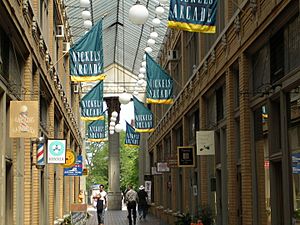
The University of Michigan is a huge part of Ann Arbor's economy. It employs about 30,000 people. This includes about 12,000 people in its medical center. Many other businesses come to Ann Arbor because of the university. They are drawn by its research and its skilled graduates.
High-tech companies, health services, and biotechnology are also very important to the city's economy. There are many medical offices, labs, and related companies. Car manufacturers like General Motors also have employees living here.
Many high-tech companies have been in Ann Arbor for a long time. Some current companies include Arbor Networks, JSTOR, and ProQuest. Duo Security, a company focused on online security, is also based here. In 2021, KLA Corporation, a company that makes equipment for testing computer chips, opened its North American headquarters in Ann Arbor.
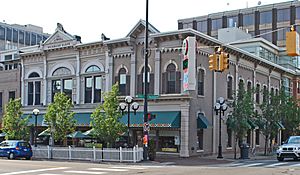
Ann Arbor is home to Internet2 and the Merit Network. These are non-profit computer networks for research and education. Google's AdWords program also has an office in Ann Arbor. The city also has many video game and virtual reality studios.
The University of Michigan runs the North Campus Research Complex. This used to be a Pfizer drug research center. Other research centers in Ann Arbor include the Great Lakes Environmental Research Laboratory (from NOAA) and the Michigan Tech Research Institute. The United States Environmental Protection Agency and the Toyota Technical Center also have facilities here.
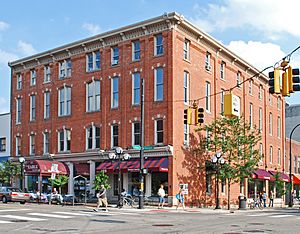
Other well-known companies in Ann Arbor include Domino's Pizza. Its headquarters are just outside the city. Zingerman's Delicatessen is another famous local business. It started as a deli and has grown into many different food businesses.
Culture and Arts
The University of Michigan campus has many performing arts groups and facilities. It also has museums for art, history, and science. The University Musical Society, founded in 1879, brings international artists to Ann Arbor. They perform music, dance, and theater. Each June, Shakespeare in the Arb performs a Shakespeare play in a large park.
Other local arts groups include the Ann Arbor Civic Theatre and the Ann Arbor Symphony Orchestra. The Ark is a popular folk music venue. The State Theatre and the Michigan Theater show movies and host live performances. A unique art feature in Ann Arbor is the fairy doors. These tiny doors are hidden in buildings around downtown.
The Ann Arbor Hands-On Museum is an interactive science center. It is in an old fire station downtown. The Ann Arbor Art Center holds art activities and shows. Ann Arbor is also known for its many bookstores. It has more bookstores and sells more books per person than any other U.S. city. The Gerald R. Ford Presidential Library is also located here.

Many annual events bring visitors to Ann Arbor. The Ann Arbor Art Fairs are a group of four art fairs held in July. They attract over half a million visitors. The Ann Arbor Film Festival is held in March. It receives thousands of film entries from around the world.

People from Ann Arbor are called "Ann Arborites." Long-time residents sometimes call themselves "townies." The city is often called "A²" or "A2," or "Tree Town." Some people jokingly call it "The People's Republic of Ann Arbor." This refers to the city's generally liberal political views.
Sports
Ann Arbor is a big center for college sports. This is mainly because of the University of Michigan. The city has several well-known sports facilities. Michigan Stadium is the largest American football stadium in the world. It can hold over 107,000 fans. It is often called "The Big House."
Crisler Center is where the university's basketball teams play. Yost Ice Arena is home to the ice hockey team. Concordia University, another local college, also has sports teams.
In semi-professional sports, Ann Arbor has a soccer club called AFC Ann Arbor. They are part of the National Premier Soccer League.
The city also has the Ann Arbor Skatepark. It opened in 2014 and is 30,000 square feet. Famous skateboarders like Tony Hawk have skated there.
Education
Schools for Kids and Teens
Public schools in Ann Arbor are part of the Ann Arbor Public Schools (AAPS) district. AAPS has one of the best music programs in the country. In the 2021–2022 school year, over 17,000 students were enrolled. Notable high schools include Pioneer, Huron, and Skyline. The district also has a preschool center.
Ann Arbor has several private schools. These include Emerson School, Father Gabriel Richard High School, and Greenhills School. There are also charter schools like Central Academy.
Colleges and Universities
The University of Michigan is the biggest college in Ann Arbor. Its buildings are right in the center of the city. This gives Ann Arbor its special "college-town" feel.
Other colleges in the area include Concordia University Ann Arbor. This is a Christian liberal-arts school. Cleary University is a private business school. Washtenaw Community College is located nearby in Ann Arbor Township.
Media
The Ann Arbor News used to be the main daily newspaper for the city. It stopped printing daily in 2009. Now, it prints twice a week and has a daily online edition called MLive.com.
Other publications in the city include the Ann Arbor Journal, a weekly newspaper. The Ann Arbor Observer is a free monthly magazine. Current is a free weekly magazine about entertainment. Car and Driver magazine and Automobile Magazine are also based in Ann Arbor. The Michigan Daily is a student newspaper from the University of Michigan. It covers local and campus news.
Ann Arbor has several radio stations. These include news, talk, country, and adult-alternative music stations. WCBN-FM 88.3 is a college radio station run by University of Michigan students. It plays many different types of music and public-affairs shows.
Ann Arbor is part of the Detroit television market. Community Television Network (CTN) is a local cable TV channel. It has production facilities that city residents can use.
City Services
Healthcare
The University of Michigan Health System (UMHS) is a major healthcare provider. It includes University Hospital, C.S. Mott Children's Hospital, and Women's Hospital. UMHS also has many clinics around the city. Other medical centers include a large facility run by the Department of Veterans Affairs.
Utilities
The city provides water and sewage services. Water comes from the Huron River and groundwater. The city has two water treatment plants. It also operates four dams along the Huron River: Argo, Barton, Geddes, and Superior. Barton and Superior dams produce hydroelectric power.
The city also handles waste management. Recycle Ann Arbor manages recycling. DTE Energy provides electricity and natural gas. AT&T Inc. is the main wired phone service provider. Comcast is the main cable TV provider.
Transportation
The streets in downtown Ann Arbor are in a grid pattern. Major roads lead from downtown to the highways around the city. Three freeways go around Ann Arbor: I-94 (south and west), U.S. Highway 23 (east), and M-14 (north). The Washtenaw County Border-to-Border Trail connects Ann Arbor to Ypsilanti for walkers and bikers.
The Ann Arbor Area Transportation Authority (AAATA), also called "TheRide," runs public bus services. These buses go throughout Ann Arbor and nearby Ypsilanti. The AAATA operates the Blake Transit Center downtown. The University of Michigan also has its own free bus service between its campuses.
The "AirRide" connects Ann Arbor to Detroit Metro Airport. Greyhound Lines offers bus service to other cities. Amtrak provides train service at the Ann Arbor Train Station. The Wolverine train runs between Chicago and Pontiac. Ann Arbor Municipal Airport is a small airport south of the city.
Sister cities
Ann Arbor has seven sister cities around the world:
- Tübingen, Baden-Württemberg, Germany (since 1965). Schools in Ann Arbor and Tübingen have regular student exchanges.
- Belize City, Belize (since 1967)
- Hikone, Shiga, Japan (since 1969). Schools in Ann Arbor and Hikone have regular student exchanges.
- Peterborough, Ontario, Canada (since 1983)
- Juigalpa, Chontales, Nicaragua (since 1986)
- Dakar, Senegal (since 1997)
- Remedios, Cuba (since 2003)
See also
 In Spanish: Ann Arbor para niños
In Spanish: Ann Arbor para niños


